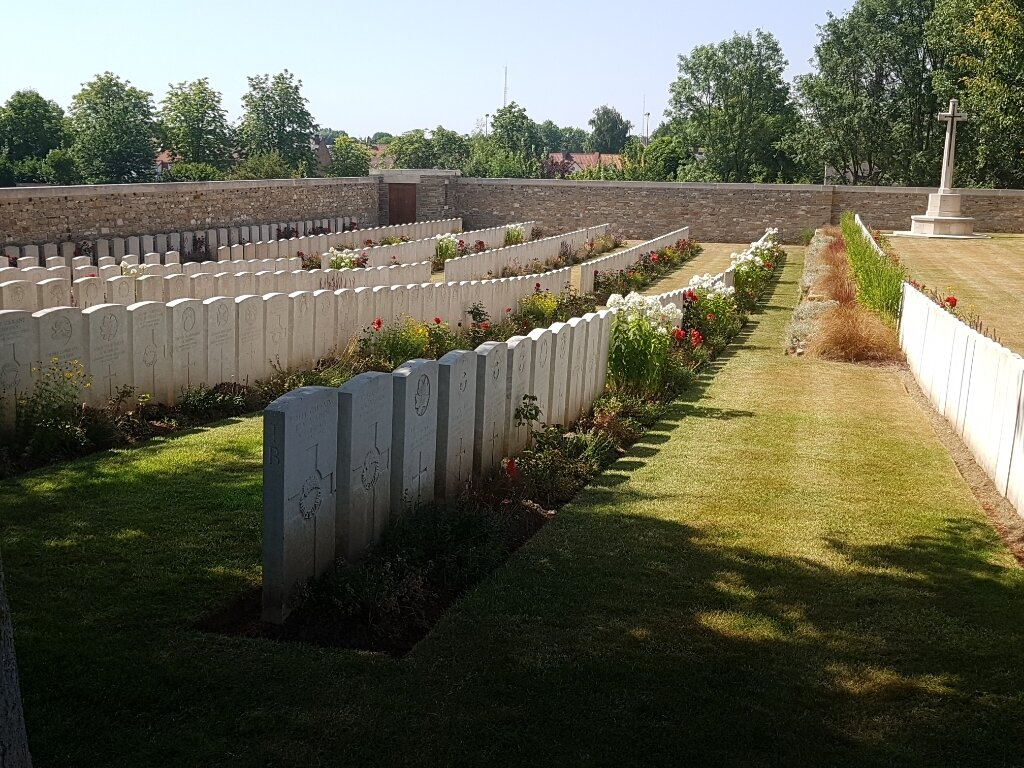CYRIL CHARLES EDWARD ROBINSON
Lieutenant, 59th Squadron, Royal Air Force
(sometime of 28th London Regt.; commissioned into the R.F.C. 7.11.17)
Killed in Action, Doullens, France, 28 April 1918, aged 22.
Buried in Doullens Communal Cemetery Extension No. 2, Somme, France.
Grave reference: 1.A.32

Doullens Communal Cemetery Extension No. 2
(Source: Commonwealth War Graves Commission)
Cyril Robinson was born in 1896 and was the son of William Charles and Charlotte Emily Robinson, née Morgan. William was born at Marlborough in Wiltshire and Charlotte at Caerphilly, Glamorgan; many working class people settled far from their birthplace during a career in domestic service.
On the 1901 census the family is living at Upper Lodge, Ashdown Park; William was the butler at Ashdown Park, Wych Cross. He is 37 years old and Charlotte is 34. The eldest child, also called William, is 9 years old and was born at Forest Row. The three younger children, Elsie, 7, Cyril, aged 4, and Ivor eleven months, were born at Hartfield. Also living with them is Charlotte's sister, Martha Morgan, an assistant school mistress. Cyril was baptised at Hartfield (31 May 1896) so it is possible that he and the other children attended Hartfield School and church.
Ashdown Park was occupied by Mrs Marianne Thompson who employed, in the house and on the estate, a total of 15 people who had in their turn 28 dependents. As butler, the senior indoor servant, William Robinson would command a good salary, the respect of the other staff and at Ashdown Park an estate house for his family. His children would not be expected to become agricultural workers.
At some point the family moved as the 1911 census shows Cyril living at 40, Torbay Rd, Brondesbury, London, NW6 with his family and is employed, aged 14, as a clerk in the Magnet Works. His father is still a butler, at a "gentleman's estate". Cyril's elder brother is a plumber, his sister a dressmaker, while Ivor is at school.
During the First World war Cyril has an enlistment date of 24 April 1916 into the 28th (County of London) Battalion, London Regiment, (Artists Rifles) with the rank of private.
Perhaps his job at the Magnet Works gave him particular qualifications or experience but in any case he was commissioned into the Royal Flying Corps on 7 November 1917.
The casualty rate for this new method of warfare was high and he was killed at Doullens, in France on 28 April 1918, aged 22.
At the beginning of the war aeroplanes were used for photographic reconnaissance work, a camera often mounted at the rear. Defensive manoeuvres by the opposing sides led to dogfights and bombing of ground positions. With solo reconnaissance the pilot had to fly, navigate, observe and transmit observations to ground base by wireless morse. When there was a pilot and observer the latter was at first senior, the pilot just the "driver" but gradually the roles were reversed as pilots often needed to take immediate evasive action. Parachutes, just being developed, were not used: senior staff felt that there would be a temptation to abandon the machine and many pilots felt their drag reduced the plane's effectiveness. Some parachutes were available to observers in tethered balloons.
The Royal Flying Corps merged with the Royal Naval Air Service on 1 April 1918 to become the Royal Air Force. Pre-RAF ranks continued to be used for serving men, the new RAF ranks gradually replacing them.
Cyril Robinson did not survive long enough to take on a new rank. His entry in the Forest Row memorial book was signed by his father, by then living in Hounslow.
Vivien Hill
13 July 2014
Revised 22 June 2022

